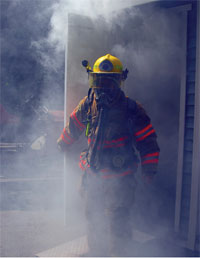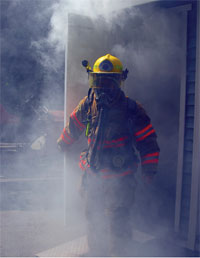
Documenting Hazardous Exposures
Industrial hygiene hazards are almost constant for first responders. In the end, they must be proactive about their own education and awareness.
 Fiery crashes of automobiles, school buses, and other motor
vehicles often require emergency responders to extricate victims
from a tangle of twisted steel and shattered glass. Hazardous
chemical spills can bring them within range of toxic fumes.
Law enforcement officers closing down a smoldering methamphetamine
lab may be walking into a site contaminated with corrosives,
solvents, acids, and other hazards that can be inhaled or
absorbed through the skin.
Fiery crashes of automobiles, school buses, and other motor
vehicles often require emergency responders to extricate victims
from a tangle of twisted steel and shattered glass. Hazardous
chemical spills can bring them within range of toxic fumes.
Law enforcement officers closing down a smoldering methamphetamine
lab may be walking into a site contaminated with corrosives,
solvents, acids, and other hazards that can be inhaled or
absorbed through the skin.
The ultimate in responder stress—building fires or a terror
attack—may result in dangerous falling debris that can include
asbestos, anthrax, and many more. Add to the airborne hazards the
smoke or dust that are so thick on some calls that you bump into
other rescuers and don’t even see them; the ear-shattering noise;
lead exposures; confined spaces; human bites from frightened victims;
radiation; asphyxiation; raw sewage; fungus and mold exposure;
and even critters that bite.
These are the IH hazards to which first responders are sometimes
exposed. Of course, there are physical hazards, too—heavy
lifting, difficult terrain, climbs and descents, the hazards of emergency
transportation to the scene, and more.
When we talk about workplace exposures, it’s hard to conceive
of a more varying and serious set of hazards than what first
responders encounter. There are none more courageous and
none more exposed to known and unknown industrial hygiene
hazards in the regular course of their work than those who deal
with front-line lifesaving.
Who’s Monitoring?
First response situations are often much more complex exposures
than those of other workplaces because of the fast-paced, transient
nature of the incident. Frequently the residue of any exposure is
gone before the effects register. Records may not be kept. Other
unknown elements are hidden because of criminal intent.
Dust, vapors, and gases from fires can dissipate unmeasured;
spills may be cleaned up and hauled off with few samples taken.
Heat and cold stress are constant foes. A first responder is apt
to be met with this: “You’ll be all right. You just need a good
night’s sleep.”
My personal opinion is that this is not malice, but ignorance of
the toxic nature of unknown substances. Rescue calls today are
completely different from the calls of years gone by. Take, for
example, the materials we use to construct our offices. No longer
consisting of wood and sheetrock, our office equipment is likely to
be made of plastics of varying composition that can emit toxic
gases when heated. Today there are no simple rescue calls because
each victim has the potential to be a carrier of potential exposures
to the first person on the scene.
First responders themselves are one of the worst exposure documentation
hindrances. Very few of these stalwarts are inclined to
report anything unusual, either not realizing potential hazards or
fearing teasing or negative reactions from others in the organization
for the report. Large-scale disasters have assisted by educating
first responders in the need to report anything and everything, but
all too often those on the front line were not even aware of the
potential exposure. Education and awareness are critical for the
first-on-scene caregivers.
At the very least, you can plan on the basics of noise, dust, fire, heat stress, cold stress, toxin exposures, and
bloodborne pathogen exposures. Documentation
is all-important in order to
determine the exposure of individual personnel.
Telling a first responder he or she
“may” be exposed is not effective; the
immediacy of the call usually will take
precedence over any fear of exposure.
Raising Awareness
Each first responder has to be made aware
of the expected and unexpected industrial
hygiene hazards he/she may face on a call
any given day. While large-scale disasters
are a possibility, daily exposures on the job
may generate few headlines but can add up
in a cumulative effect over a lifetime.
Responders must balance potential exposures
with the call and their ability to
rescue the victim. Knowing the potential
toxics, how they are dispersed, and what
PPE will help protect them is a priority.
Getting each to wear the needed PPE
becomes a personal responsibility for every
responder facing a call.
First responders perform their tasks
based on awareness and repetitive instruction.
Full awareness goes beyond the
basics of how toxins or other industrial
hygiene exposures can invade the body.
(The simple routes of entry are inhalation,
skin absorption, ingestion, and injection.)
Each first responder must know the
warning signs for potential exposures and
how to relate what they experience in a
way that can document exposures completely.
Some rescue cases can result in
multiple exposures that may not appear as
life-altering as later testing can show—and
exposures to public health emergencies,
such as cholera, or anthrax, or even Ebola
contamination, may not even be immediately
apparent to the first responder.
Quality follow-up is needed to ensure
those exposed are cared for appropriately.
Following up every exposure may
depend on awareness of the incident aftermath
and which toxic materials were present.
It is unfortunate but true that responders
have to be proactively involving in
their own safety, both because it is a priority
thanks to the nature of their jobs and
because of the isolation the job entails.
How Do We Protect Them?
Protection comes from going beyond education.
More than the exercises each first
responder carries out to make sure all
training is to second nature, departments
have to go the extra effort to ensure each
first responder understands what to look
for with exposures and how to correctly
report any problems. Handouts, charts,
and discussion groups may help.
For each potential industrial hygiene
exposure, minimum contact routes and
times for exposure and the symptoms are
needed. Family members’ feedback can
help to fill in blank areas. We tend to treat
what we see first, such as physical injuries,
without always considering the long-term
health exposures.
In the end, first responders must be
proactive about their own education and
awareness.
This article originally appeared in the December 2007 issue of Occupational Health & Safety.